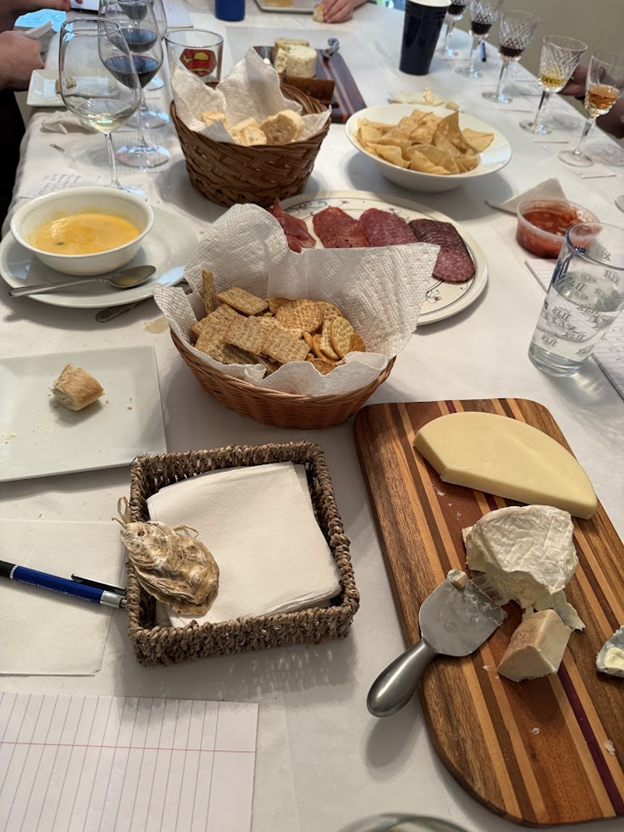Four Little Secrets I Learned from Hosting Blind Wine Tastings
- Marla
- Sep 4
- 4 min read

Our readers know that my family likes to challenge me by holding a blind wine tasting and seeing how well I do.
Well, why should I get all the fun? So this summer, I hosted two blind wine tastings for the rest of the family. Both tastings went smoothly and were great fun!
Let me share what we did – and four little secrets I learned from hosting blind wine tastings that will improve the event even more.
How We Set Up the Tastings
For the first tasting, we decided to focus solely on red wines, as the participants are more red wine drinkers. We opted to use single varietals only, which I thought would be easier to identify (they weren’t).
We used six different wines, from various places:
· Cabernet Sauvignon, Paso Robles, California
· Malbec, Mendoza, Argentina
· Merlot, Napa Valley, California
· Mourvèdre, Paso Robles, California
· Pinot Noir, Willamette Valley, Oregon
· Zinfandel, Sonoma, California

I also created notecards with detailed descriptions for each wine that our tasters could work from. We were not competitive, and there was some discussion, although tasters made their own decisions, and we went through several rounds until all of the wines were correctly identified.
The second blind taste test was slightly different, since we used three red wines and three white wines, none of them domestic. We also opted not to use the notecards until the second round just to make it a bit more challenging.
The white wines were:
· Chardonnay, Beaune, France
· Sauternes, Preignac, France
· Sweet Rhubarb Wine, Prince Edward Island, Canada
And the reds:
· Malbec, Mendoza, Argentina
· Pinotage, Bot River, South Africa
· Red Rhone, Hermitage, France

The results? In the first tasting, one family member was more successful than the others. In the second one, a different family member came out ahead. So it was pretty evenly matched. Whew!
Four Little Secrets I Learned from Hosting Blind Wine Tastings
We’ve held several blind wine tastings in the past few years, so we’ve gotten the hang of it: provide snacks and palate cleansers, enable note-taking, etc.
But now that I have been the host, I have learned that there are ways to fine-tune the event and make it even better. Here are four little secrets I've learned from hosting blind wine tastings.
1. Don’t Overpour
For the first tasting, I was, um, a bit generous in my pours. The glasses looked pretty, but we didn’t need that much wine to start with in the tasting glasses. I wasn’t looking to get anyone tipsy. Also, by general consensus, the Merlot was a standout, and we all wanted more of it after the tasting was over, but there was just a little left in the bottle. Oh well.
2. Don’t Inadvertently Mislead the Participants

In the first taste testing, the Mourvèdre’s cork broke while opening the bottle, so I ended up decanting the wine. But my family is pretty savvy, and one taste tester reasonably assumed that the decanted bottle was the oldest, the 2012 Merlot, which sent him down the wrong path. I inadvertently created a bias. My bad.
In the second taste testing, the top of the Pinotage bottle broke off when I opened it, requiring another decanting. This time around, I made sure to tell people that the decanter was solely because of the bottle casualty; it was not a hint.
3. Include at Least One Easy Guess
While I thought during the first tasting that my team would immediately correctly guess at least the Zinfandel and Pinot Noir as those wines are very popular in this house, tasting six reds at once was actually much harder, and one family member got all six wrong in the first round, which bummed him out a little. I didn’t want people to be frustrated; this is supposed to be fun.
As a result, we made the second blind taste testing easier (although still challenging) by using three whites and three reds, so there would be fewer choices in each. I also included Chardonnay since I thought everyone would be familiar with that, and for the other two whites used two very different types of wines that are pretty distinctive: the rich Sauternes, known to pair with dessert or fatty foods, and the rhubarb wine, with a more unique taste. Everyone correctly identified the Chardonnay, and a couple nailed the Sauternes.
4. Don’t Stress Out
I wanted the tastings to run perfectly. I worried and scurried about so much that the tasters finally told me to sit down, relax, and enjoy myself as well. They were right! It’s a blind wine tasting, not a serious event. Even the host should have fun.
I hope our four little secrets I learned hosting blind wine tasting will help you the next time you join or host one. Do you have any additional little secrets learned from hosting or participating in a blind wine tasting? Let us know! We’re at info@winewithourfamily.com.
If you enjoyed this post, check out our website and some of our related articles:




Comments